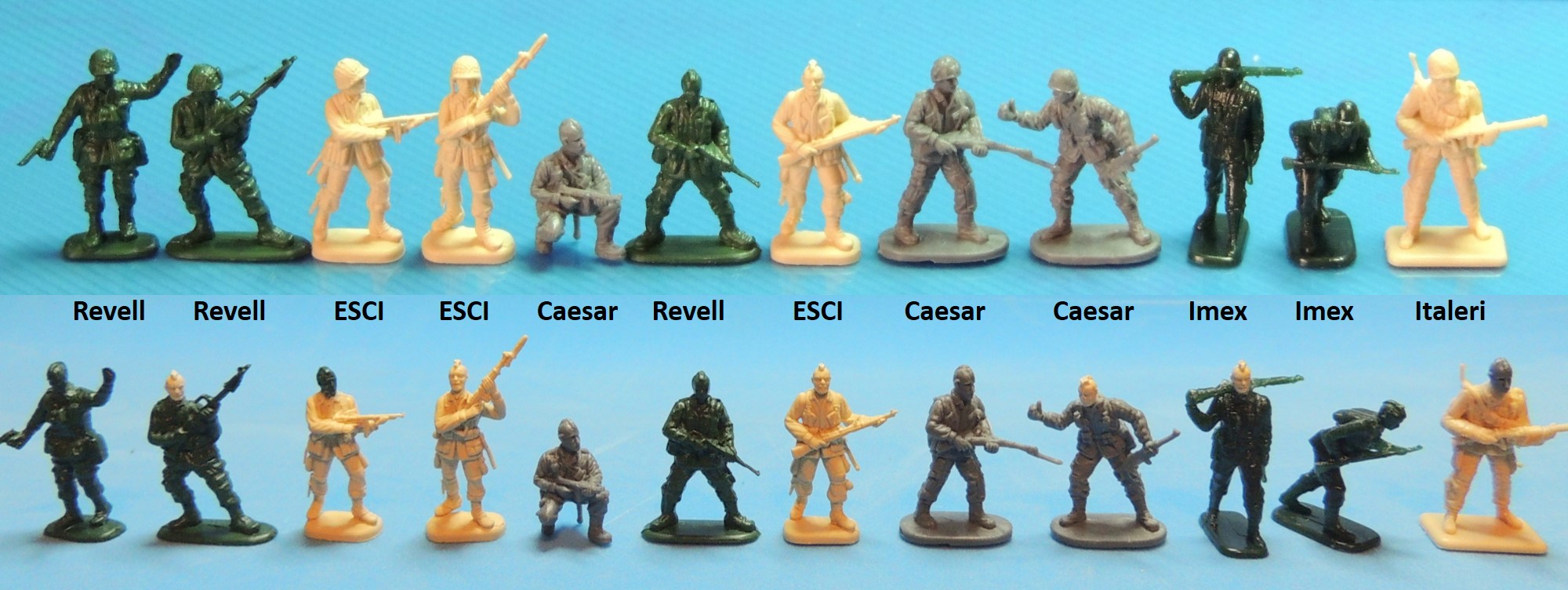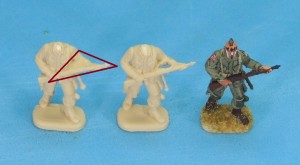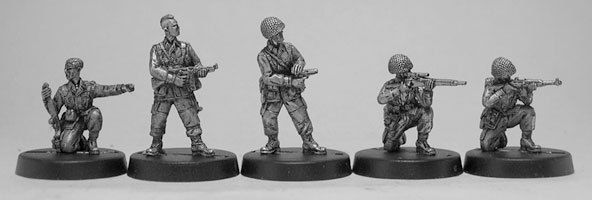II. The Red Army Politruk in WWII
III. The Kombat Figure in 1/72
A. ESCI 203 Russian Soldiers (1982)
B. Revell 02510 Soviet Infantry (1994)
C. Zvezda 8077 Soviet Infantry Platoon (2012)
D. Other Box Covers
E. The Figures
IV. The NKVD Commissars in 1/72
A. The Commissar from A to Z (Atlantic to Zvezda)
B. Other Soviet Officers
C. CP & TQD White Metal Officers
D. Painting the Figures
V. The Political Officer in Russian Cinema
VI. Lagniappe: Der Kommissar’s in Town by After the Fire
I. Kombat
Possibly the most iconic Soviet image of World War II is this photo of a political officer exhorting his comrades to battle on the Eastern Front. Entitled Kombat (a portmanteau of komandir and batal’on, literally “battalion commander”), war correspondent Max Alpert’s timeless photo depicts Alexey Yeremenko, of the Soviet 220th Infantry Regiment, who was not a battalion commander but a politruk (political officer), just minutes before his death during fighting in Voroshilovgrad Province, Ukraine, on July 12, 1942.
Alpert’s image holds a special place in the Russian imagination and has been immortalized in monuments in the former Soviet Union.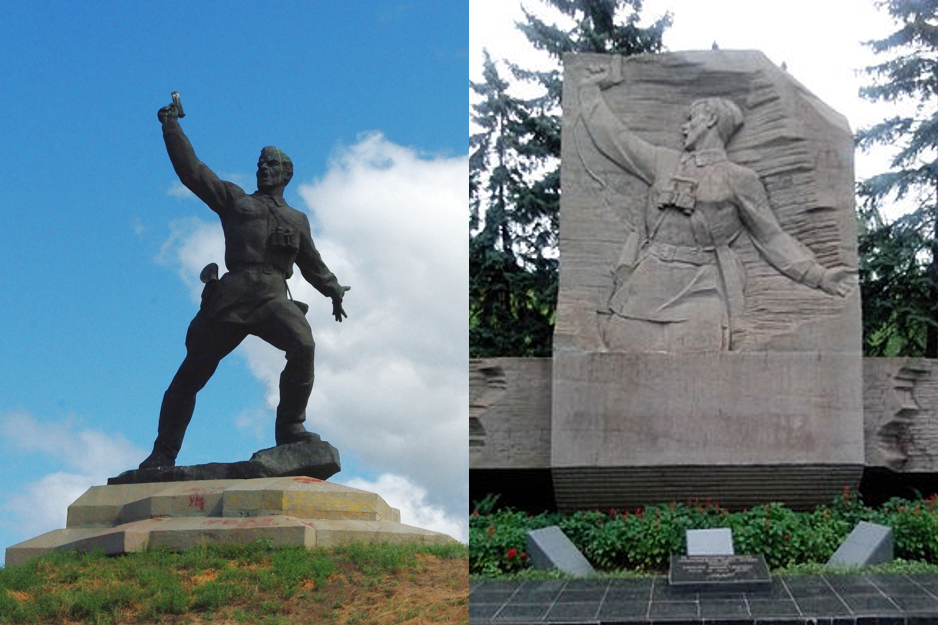 The bronze statue at left is in Stepove; the stone monument at right is in Zaporizhia, both in southern Ukraine, where Yeremenko, who was Ukrainian, was killed.
The bronze statue at left is in Stepove; the stone monument at right is in Zaporizhia, both in southern Ukraine, where Yeremenko, who was Ukrainian, was killed.
Yeremenko’s image has also appeared on postage stamps and commemorative coins.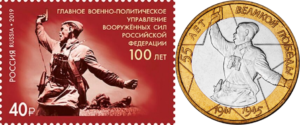
As recently as 2017, a commemoration of the 75th anniversary of Alpert’s photo took place in Sloviansk, Ukraine.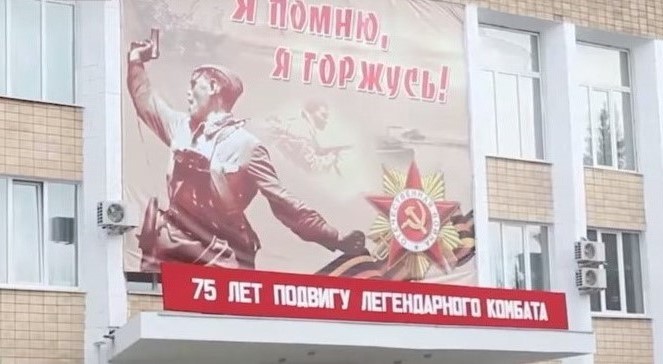
Our hobby — ideally a miniaturized reflection of actual historical events — has not been immune from the photo’s allure, with three manufacturers offering a 1/72 scale plastic model of Yeremenko. However, before delving into the 1/72 world, a short description of the politruk (a Russian portmanteau of politicheskiy and rukovoditel, literally “political leader”) is in order.
II. The Red Army Politruk in WWII
In broad terms, the politruk, commonly referred to as “political officer” or “political commissar,” was a military official appointed specifically to ensure civilian control of the military — at least in theory. In practice, the politruk ensured the Soviet military remained under the Bolshevik Party’s control. To become a political officer, an individual must have been registered as a communist and attended special political training. Units from company to division had two officers — a military officer in charge of military decisions, and a political officer of coequal rank and authority who ensured those decisions were carried out in accordance with Communist ideology. Although most lower-level political commissars had little or no military training, they had the authority to countermand the unit’s commander if in their estimation an order undermined party dogma.
The politruk position came and went, abolished and restored as circumstances dictated, and its role morphed as necessary, with slightly different roles at different times during the war. At the outset of the conflict, 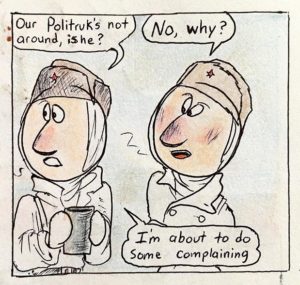 the politruk’s primary function was to ensure that soldiers did not retreat in the face of the German onslaught and had authority to shoot transgressors on sight. Following the Red Army’s heavy losses in 1941 and 1942, the dual-command system was deemed unworkable. Politruks were removed from direct command and charged with improving morale, ensuring regulations were followed, indoctrinating troops, and spreading communist propaganda. Thus, distilled to its essence, the politruk’s function was to interpret everything he saw through a political lens and ensure all actions were in accordance with party ideology. Many a Soviet soldier lost his life because a politruk informed on him. The cartoon at left by Knottipine, from the instabusters website, aptly captures what most Red Army soldiers thought of the omnipresent politruk [instabusters website].
the politruk’s primary function was to ensure that soldiers did not retreat in the face of the German onslaught and had authority to shoot transgressors on sight. Following the Red Army’s heavy losses in 1941 and 1942, the dual-command system was deemed unworkable. Politruks were removed from direct command and charged with improving morale, ensuring regulations were followed, indoctrinating troops, and spreading communist propaganda. Thus, distilled to its essence, the politruk’s function was to interpret everything he saw through a political lens and ensure all actions were in accordance with party ideology. Many a Soviet soldier lost his life because a politruk informed on him. The cartoon at left by Knottipine, from the instabusters website, aptly captures what most Red Army soldiers thought of the omnipresent politruk [instabusters website].
The Germans so feared political commissars that on June 6, 1941, just prior to the invasion of the Soviet Union, the German High Command issued the “Guidelines for the Treatment of Political Commissars,” commonly known as Kommissarbefehl (Commissar Order), directing the German army to summarily execute any captured political commissars as enforcers of “Judeo-Bolshevism.” Predictably, the Commissar Order resulted in an unwillingness to surrender by Soviet forces and the upshot was increased Soviet resistance to the Werhmacht. Nonetheless, thousands of commissars are believed to have been executed before Hitler cancelled the Commissar Order exactly a year after it was issued.
III. The Kombat Figure in 1/72
Three plastic soldier manufacturers have tried their hand at sculpting Yeremenko’s distinctive pose — ESCI, Revell, and Zvezda — and all three feature the pose on their Soviet soldiers box covers, as can be seen below. There’s little sense in providing thoughts on these three sets as the terrific Plastic Soldier Review (PSR) website has done a thorough review of each. Click on each title to access the PSR review.
A. ESCI 203 Russian Soldiers (1982)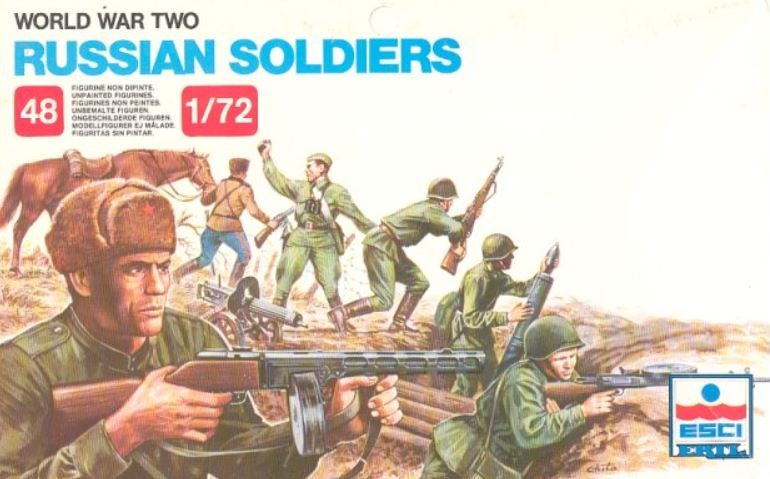
B. Revell 02510 Soviet Infantry (1994)
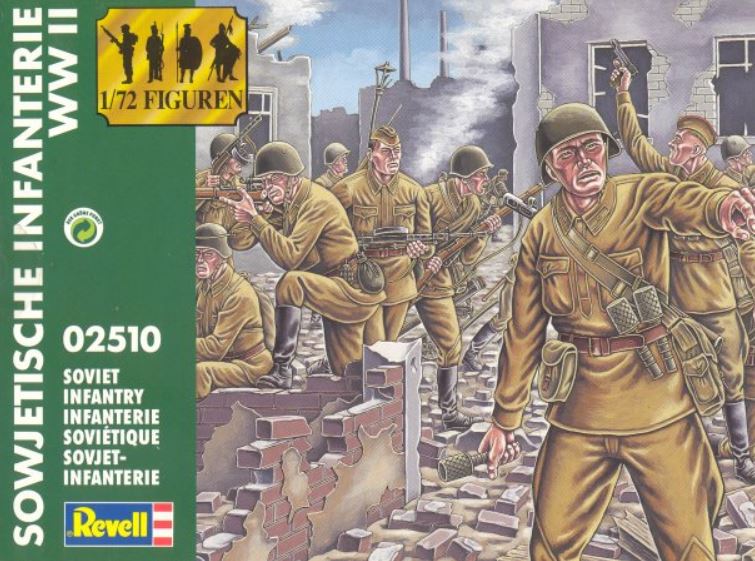
C. Zvezda 8077 Soviet Infantry Platoon (2012)
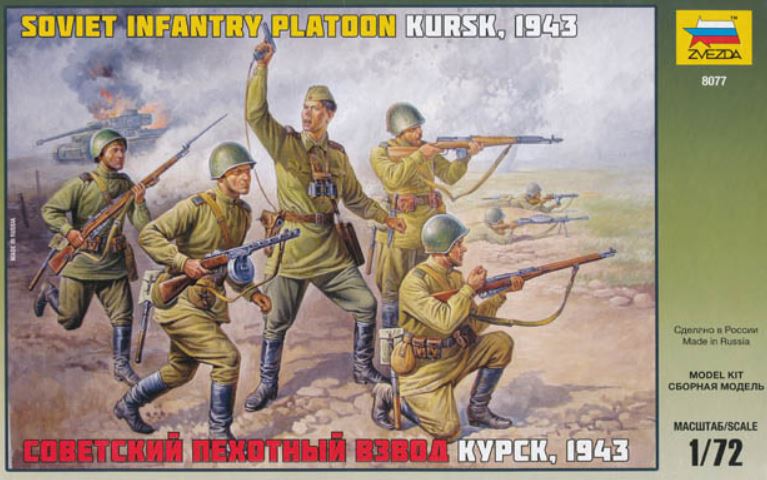
D. Other Box Covers
ESCI re-released their 203 Russian Soldiers set in a diorama pack entitled Berlin: Die Götterdämmerung (“Berlin: Twilight of the Gods”). A-Toys 1103 also released the ESCI set in a combination pack with the ESCI 201 German Soldiers. Finally, Revell re-released their 02510 Soviet Infantry with new box art. Note that all three boxes have a depiction of Yeremenko’s image somewhere on the cover.
E. The Figures
As is readily apparent from the photo below, the three sculpts vary significantly, with the ESCI figure being the smallest and the Revell figure being the tallest. I found that under high magnification all three sculpts hold up fairly well, with the Zvezda figure having the greatest detail and the Revell figure the least — the Revell figure’s facial features are particularly poorly defined. To my eye, the ESCI figure has the best anatomical proportions as I find the head on the Zvezda a smidgen oversized. On the whole, however, the Zvezda figure most closely resembles Yeremenko’s pose, though the sculptor gave him a closed left hand, probably to make the sculpting easier.
IV. The NKVD Commissars in 1/72
Yeremenko’s uniform notwithstanding, the typical Red Army commissar belonged to the NKVD (People’s Commissariat for Internal Affairs) and was characterized by a different and distinctive uniform: olive green gymnastiorka shirt-tunic (same as the three figures above), blue sharovari trousers, high black leather boots, Sam Browne brown leather belt with its distinctive strap passing diagonally over the right shoulder, holster for the Tokarev TT-33 pistol, brown webbing, and a sky blue peaked cap with a red band and a black visor. Like all Red Army headgear, the cap bore on the forehead a red star on a gold background. Some officers also carried a brown dispatch or map case and, in the field, a brown case for their black binoculars. However, a surefire way to recognize a political officer was the distinctive red worsted star with gold hammer and sickle on the sleeves, about two inches in diameter and three inches from the cuff.
This photo of a painted Evolution Miniatures EM-35122 NKVD 1/35 figure portrays the typical uniform of an NKVD officer.
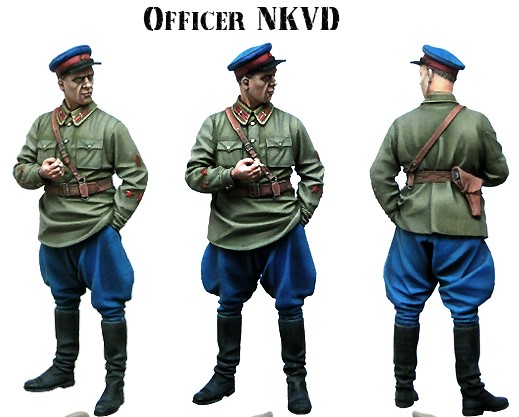
A. The Commissar from A to Z (Atlantic to Zvezda)
The photo below shows Soviet officers from the various plastic soldier manufacturers painted in the typical commissar uniform. While there’s loss of detail with a photograph of the whole lot, comparison of relative sizes is possible. Click the photo to enlarge.
To provide higher resolution and better appreciate the figures, I also photographed five at a time. Below is the first tranche.
1. Atlantic 84 Red Army
This is possibly the scrawniest officer in the history of 1/72 scale plastic soldier models. PSR called this set no more than a poorly sculpted “toy.” However, I find the sculpting, at least on this particular figure, considerably better than the miserly 3 out of 10 for sculpting the set received on PSR and, in fact, the facial features are fairly well defined.
2. Hat 8263 Russian Tank Riders
At first blush, these Hat soldiers are, as PSR put it, “not particularly appealing figures.” Surprisingly, however, though admittedly a bit clunky, they paint fairly well. PSR called this “[n]ot a great sculpt but a very worthwhile set.” I found the detail to be not too bad and, while the PPSh-41 is not particularly well detailed, it is easily recognizable. However, the Sam Browne belt on this officer goes over the left shoulder, which is incorrect. This is one of four figures wearing the traditional gymnastiorka shirt-tunic (Plastic Soldier, Revell, and Zvezda are the other three). The figures in this set come without bases as they are intended to sit on a tank. I added the base to ensure consistency in comparing height.
3. Italeri 6131 Anti Tank Teams
The first thing that strikes you about this officer is his huge size. The head and hands are particularly large when compared to the other figures. While PSR rated these figures as being of average size, I’m fairly certain the entire set is well overscaled. Still, I don’t mind using one soldier from the set as there were, in fact, men in WWII who were considerably larger than the average. Known as the “Gargoyle,” Japanese Vice-Admiral Jisaburō Ozawa, for example, was 6’7”. The other notable feature about this officer is that he looks to be wearing the fur lined polaschubuk sheepskin coat.
4. Pegasus 7269 Russian Infantry Winter Dress 1
This was Pegasus’ first attempt at this advancing officer pose. This figure and its twin in 7272 (No. 5 below) are the only ones wearing the telogreika quilted jacket and trousers. While it is not a bad sculpt, the photo hides the excess plastic between the PPS-43 submachine gun and the body, where the area is blind to the mold. Although an officer, he does not carry a pistol as there is no holster on the figure. Finally, his submachine gun has no shoulder sling to carry it. It bears noting that PSR gave this set a perfect 10 for sculpting.
5. Pegasus 7272 Russian Infantry Winter Dress 2
Initially indistinguishable from its twin in 7269 (No. 4 above), this was Pegasus’ second attempt at the pose. By molding the figure in two parts — the right arm and submachine gun are a separate piece — Pegasus solved the excess plastic problem and produced a significantly improved figure. Note that making this a two-part figure also allowed Pegasus to add a shoulder sling to the submachine gun. This being an officer, Pegasus correctly added a gun holster and, upon closer inspection, shoulder boards.
Below is the second tranche. (Yes, alphabetically the Plastic Soldier figure should have come before Preiser as in the photo above showing all ten figures. Sorry, senior moment. 😳 )
6. Preiser 72522 Soviet Infantry Riflemen and Partisans
Despite an 8 score for sculpting from PSR, to my mind this Preiser hard plastic figure is the best sculpt in the lot. Proportions are perfect and facial features and hands are well defined (even at this scale you can count all five fingers on his left hand). However, I do have my doubts about the peaked cap, which looks suspiciously like a German peaked cap. Soviet peaked caps tended to be completely round, like the other nine in the group. Akin to the second Pegasus figure (No. 5 above), this is a two-part sculpt comprising the body and two options for the left arm. Like the Hat figures, the soldiers in this set have no bases. I added the base to ensure consistency in comparing height.
7. Plastic Soldier 20001 Russian Infantry in Summer Uniform
Generally speaking, I’m not partial to Plastic Soldier sculpting as the figures tend to be rather short and chunky. Because Plastic Soldier figures are intended for wargaming, which requires constant handling, these hard plastic figures must be robust, like their 28mm metal counterparts. This particular figure, however, is oddly pleasing and passes for a rather rotund, well-fed commissar. Like the Preiser and second Pagasus figures, this officer is made up of two parts, with the left arm being a separate piece. PSR noted that the “extra parts make some of these poses particularly deep and natural,” and gave the set a 10 for sculpting. My only quibble with this officer is that he’s carrying his right hand gun holster cross draw, i.e., on his left hip as Hollywood tells us was done in the Wild West, but something WWII officers would be unlikely to do.
8. Revell 02510 Soviet Infantry
As PSR points out, this Revell set was generally overscaled, with most figures 26mm tall, well above the average 25mm for 1/72 scale soldiers. However, this particular chap is about the right size, though, to my eye, he has an odd feminine shape with pronounced hips and a very small head compared to the rest of the figures — particularly the Plastic Soldier figure, whose head is twice as large. This officer is the prototypical commissar who does not engage in combat, as he is lacking a pistol holster or any webbing at all.
9. Ultima Ratio UR003 Soviet and Polish Infantry
In addition to the typical accoutrements of an officer — peaked cap, pistol holster, and binoculars — this commissar also carries a map and is armed with a PPS-43 submachine gun. This is an attractive figure, though his ears are so large — just take a gander from the back — that he would be completely at home in the Caesar 105 Goblins set. There are four officer poses in this set — three Poles, as indicated by their traditional Polish four-pointed rogatywka peaked cap, and this Soviet officer.
10. Zvezda 6179 Soviet Regular Infantry
To my mind, this is probably the second best figure in the group and is basically a peaked cap version of the Kombat pose that spawned this article. He wears a dispatch case over the left hip and a pistol holster over the right. The detail is crisp as is typical of Zvezda figures. PSR described this set as “perfectly well done and very natural” and “the sculpting . . . of the usual high Zvezda standard.”
B. Other Soviet Officers
Below are a few other figures that can be used as Soviet officers, purely for the sake of completeness.
1. Zvezda 6161 Soviet Cavalry
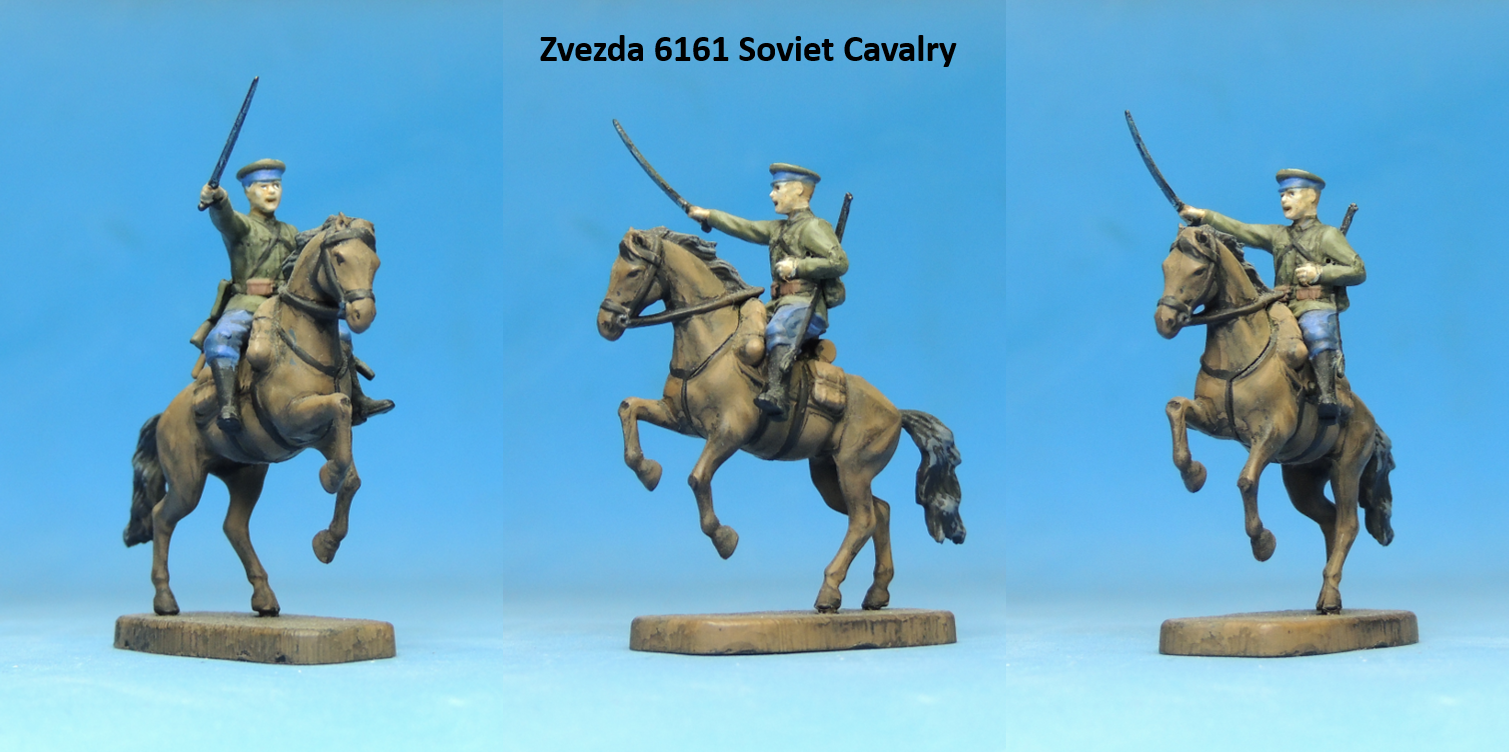 2. Zvezda 6144 Soviet Frontier Guards
2. Zvezda 6144 Soviet Frontier Guards
Click on the photo to enlarge.
As was pointed out by a commenter, these four are not all officers. The peaked cap was an element of the NKVD uniform — of which the Frontier Guards was a part — for all ranks. However, any of these figures can be used as officers.
To my knowledge, these are all the Soviet officers — or those with a peaked cap that can be used as officers — available in plastic in 1/72, with two exceptions: Preiser 72526 Soviet Tank Crewmen and Zvezda 6132 Soviet Headquarters, both of which include an officer, and neither of which I could get in time for this post.
C. CP & TQD White Metal Officers
After I had finished painting and photographing the plastic commissars and writing this post, I discovered that CP Models and TQD Castings have a diverse assortment of 1/72 scale Soviet sets in white metal. I ordered the sets that included officers and got them just in time to include below. Note that I only photographed the ones with officers or with a peaked cap, though some sets include several non-peaked cap figures.
1. CP-SOV01 Red Army Infantry with Officer
2. CP-SOV04 Red Army Banner Party
3-5. TQD-RI10 Red Army Officers
6-10. TQD-RK02 NKVD Riflemen I
11. TQD-RK04 NKVD Interrogators
12. TQD-RK05 NKVD Mortar and Anti-Tank Rifle
13-15. TQD-RK06 NKVD Maxim Heavy Machine Gun
As far as I know, these are all the Soviet officers or those with peaked cap available in the CP/TQD line except for TQD-RK03 NKVD Riflemen II, which I could not find.
D. Painting the Figures
In painting these figures, I used Vallejo acrylic colors almost exclusively as listed below. However, I used Testors enamel gold on the peaked caps, buttons, and buckles as I find metallic colors look more realistic in enamel. The Soviet uniform varied somewhat in the shade of green during the war, depending on what fabric was available, so modelers have some latitude in choice of color.
The photos below show four figures undergoing the painting process: The first photo shows them unpainted out of the box; the second photo shows them primed with surface primer; and the third photo shows them fully painted. These four figures are my first serious attempt at painting using various shades of the same base color — a technique most noticeable on the trousers. While the result may not reflect it, I actually spent considerable time painting the faces using various shades of Vallejo’s flat flesh. If anyone is wondering, I fully recognize that going into battle with a bright blue peaked cap is asking for it.
For those interested, I used the following Vallejo Model Color acrylic paints, going from head to toe:
70.963 Medium Blue – top of caps;
70.957 Flat Red – band on caps;
70.861 Glossy Black – peak on caps
70.955 Flat Flesh – faces and hands;
70.921 English Uniform – tunic on Preiser and gymnastiorka on Zvezda;
70.983 Flat Earth – coats on Italeri and Ultima Ratio;
70.918 Ivory – sheepskin trim on Italeri coat;
70.963 Medium Blue – trousers;
70.950 Black – boots;
70.940 Saddle Brown – Sam Browne belts and webbing;
70.863 Gunmetal Grey – pistols and submachine gun on Ultima Ratio;
70.950 Black – binoculars;
70.912 Tan Yellow – bases;
74.601 Grey Surface Primer – all figures; and
1144 Testors Enamel Gold – buttons, buckles, and star on caps.
V. The Political Officer in Russian Cinema
Politruks are ubiquitous in contemporary Russian cinema and television and, at least for this non-Russian-speaking outsider, hint at an apparent love-hate relationship with them on the part of the Russian public. Often portrayed as petty obstructionists, a quick survey of recent Russian shows on Amazon Prime will reveal that the politruk has become a popular staple of Russian films, which are often based on older Soviet literature. An outstanding series currently on Amazon Prime, Night Swallows, about Soviet female pilots in WWII, depicts a pesky political commissar whose mission in life appears to be to make life miserable for the pilots. A similar portrayal can be seen in Stalin’s Tanks, about the legendary T-34 tank. However, in both films the politruk displays some positive traits, including falling in love with one of his victims. A much more positive characterization can be found in Spies, a lavish series about Soviet female spies in WWII.
For a downright chilling portrayal that likely hews closest to reality, the reader is directed to Life and Faith, a series based on Vasily Grossman’s 1960 book that was banned in the Soviet Union due to its brass-knuckled depiction of Stalinism and Soviet culture. The book was considered so detrimental to the Soviet state that it was not published until 1980, when a copy of the manuscript was smuggled out of the Soviet Union. Finally, the summary execution of a political officer under the aforementioned Commissar Order can be seen in the Belorussian film Fortress of War, a harrowing account of the siege of Brest Fortress in Belarus, in June 1941. Yefim Fomin, who commands the defense of the fortress, is ultimately captured and summarily executed after declaring, “I’m a commissar, a communist, and a Jew.”
The politruk was also the subject of a compelling scene in Hollywood’s 2001 Enemy at the Gates. Starring Joseph Fiennes as political officer Danilov and Bob Hoskins making a cameo appearance as Stalingrad’s chief political officer Nikita Khrushchev, the scene captures the essence of what a political officer is supposed to do. Khrushchev eventually succeeded Stalin as Premier of the Soviet Union. Tellingly, Volume I of his memoirs is entitled “Commissar.” For those interested, I’ve pasted below a clip of that scene from YouTube. Unfortunately, the clip comes with YouTube advertisements. Please close the ad when it pops up.
VI. Lagniappe: Der Kommissar’s in Town by After the Fire
For those not familiar with the reference in the title of this post, Der Kommissar was a Billboard Top 10 song recorded by After the Fire in 1982 — actually a cover of Falco’s 1981 German language song of the same title. On the surface, the song is about a reckless young woman living in the fast lane, high on cocaine. However, Der Kommissar is in reality a protest song about the state security police in the socialist Eastern Bloc countries before the fall of the Soviet Union, whose role was essentially unchanged from that of the Soviet political commissars of WWII. By the early 80’s, citizens were increasingly resentful of the secret police who watched their every move and kept surveillance files on them, though it was still uncommon for individuals to air these grievances. The song, with its Don’t turn around, Der Kommissar’s in town refrain, was groundbreaking and reflects the transformation in the social conscience that was beginning to take place. To conclude this post, I’ve pasted below the official video of the song from YouTube.
Thank you for your indulgence and I hope you enjoyed the post. If something looks amiss, please let me know. I would be delighted to correct inaccurate information so that this may be useful to other 1/72 scale collectors and wargamers. As always, comments, questions, corrections, and observations are welcome.

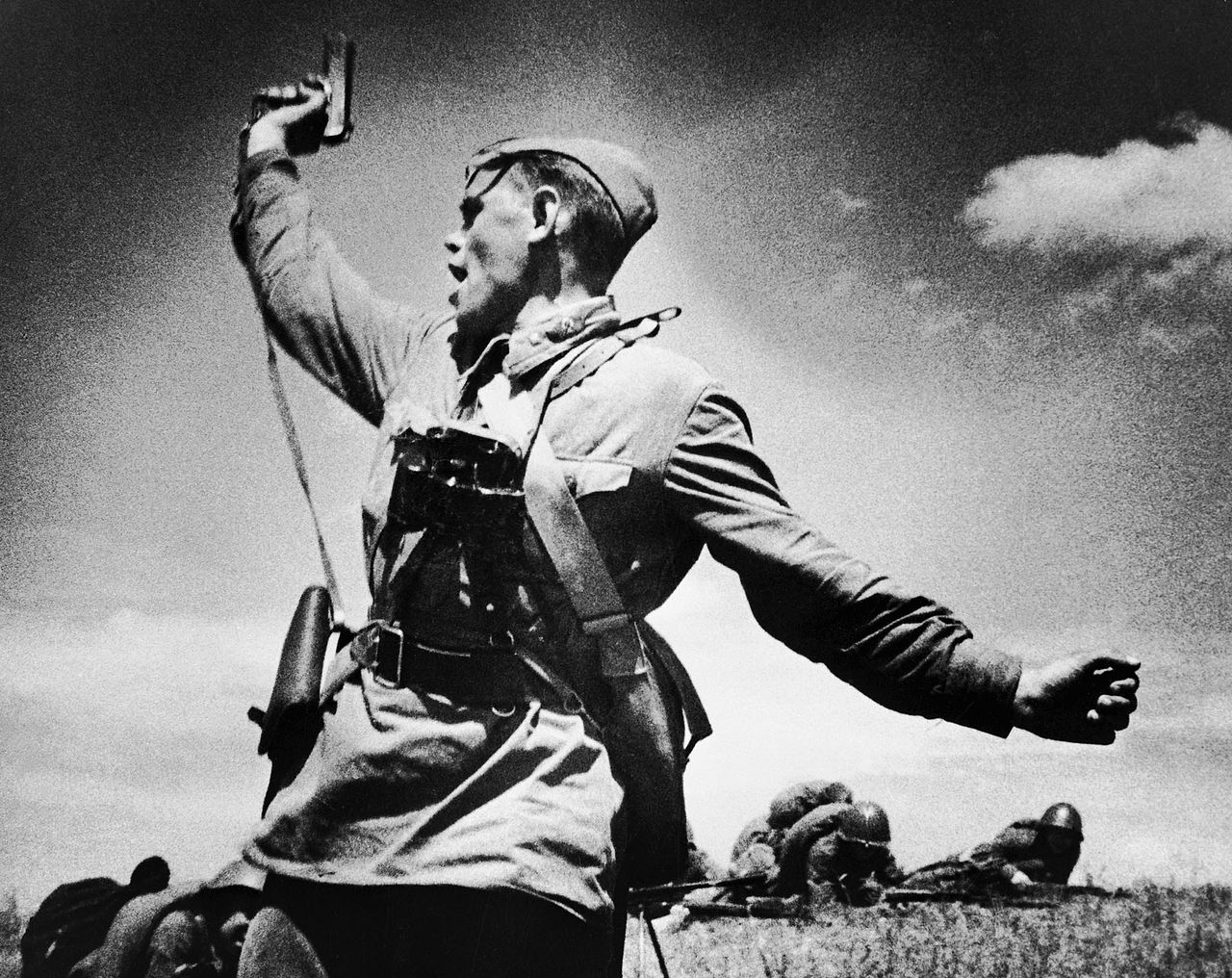
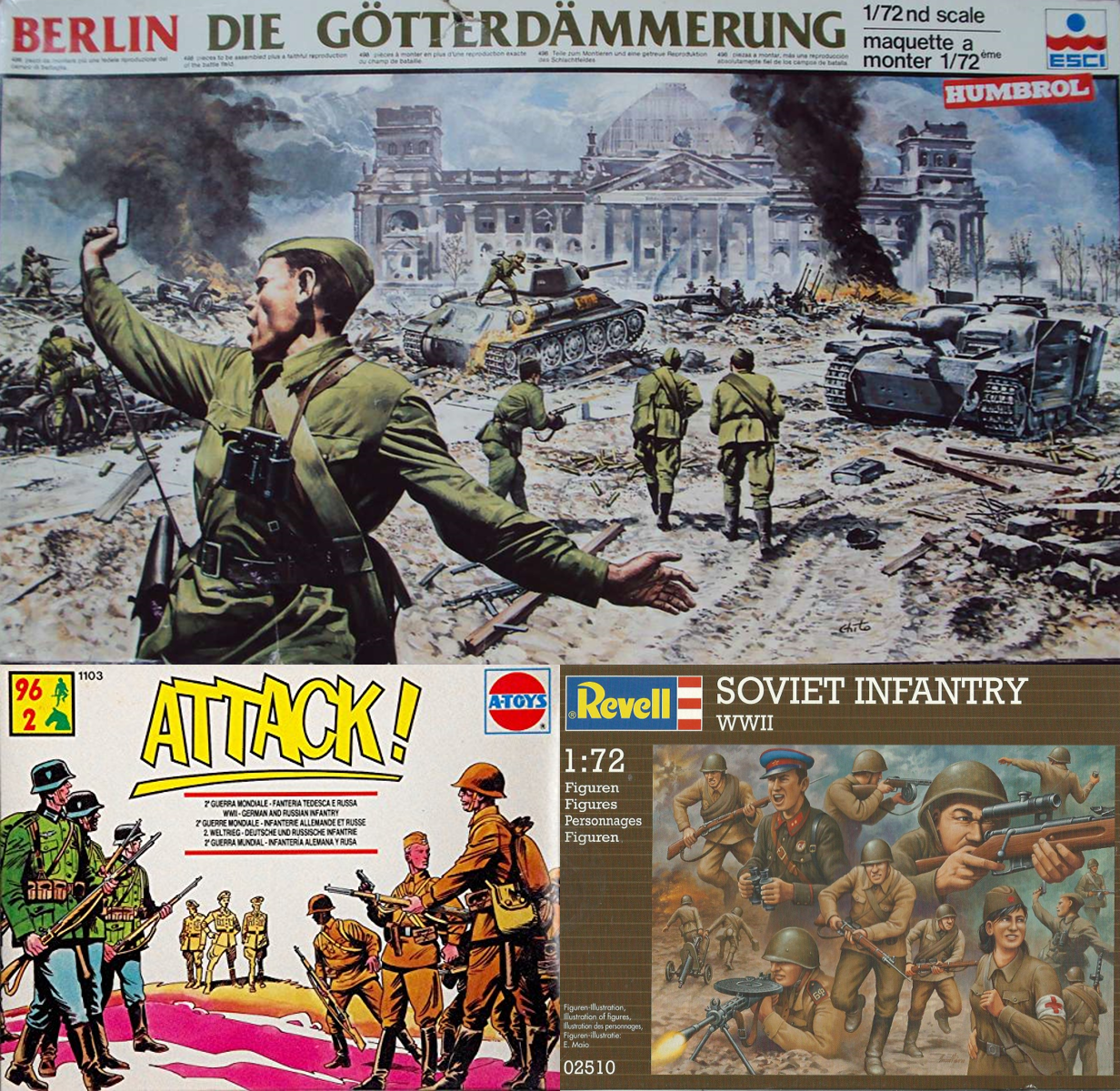
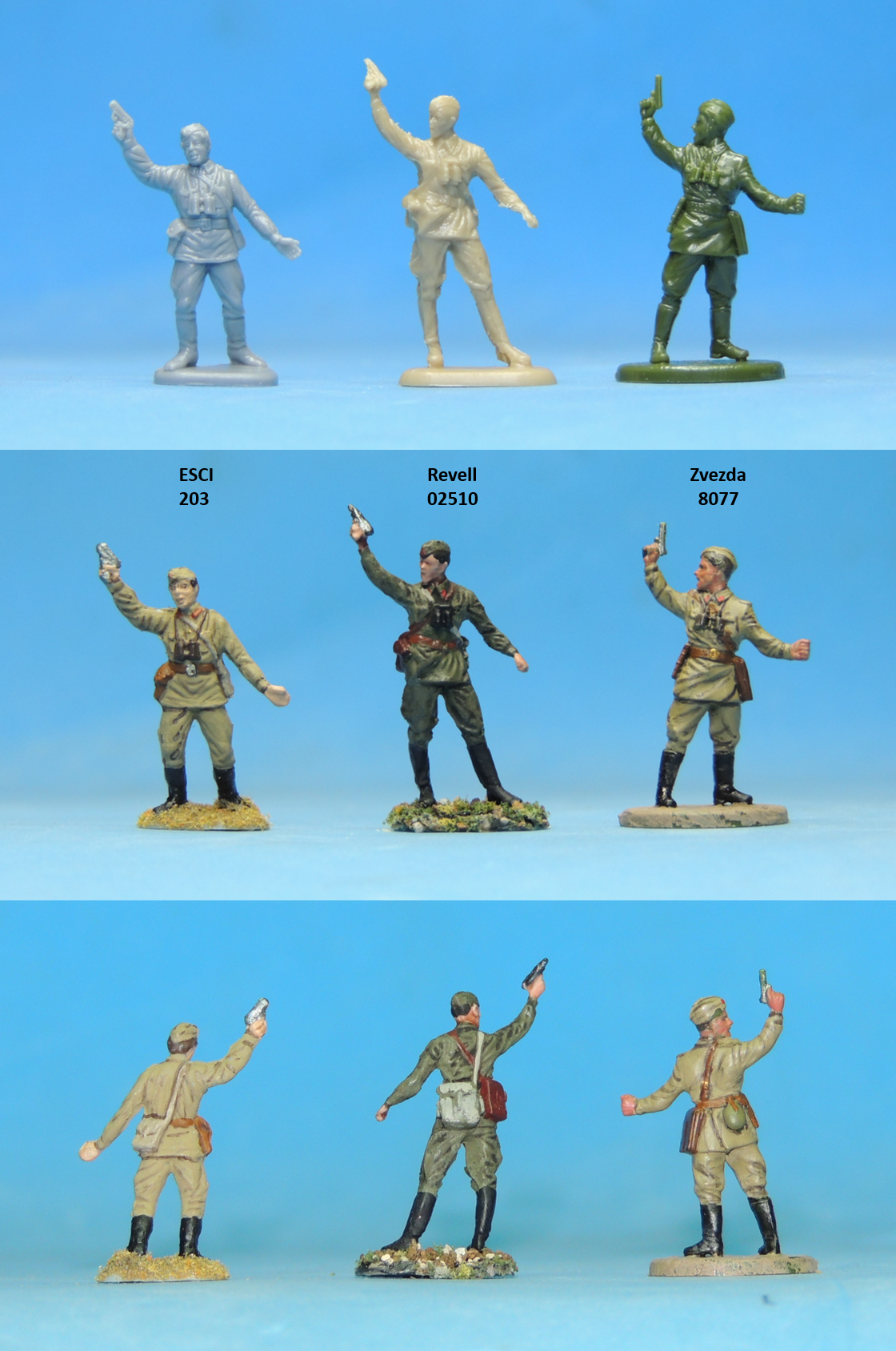
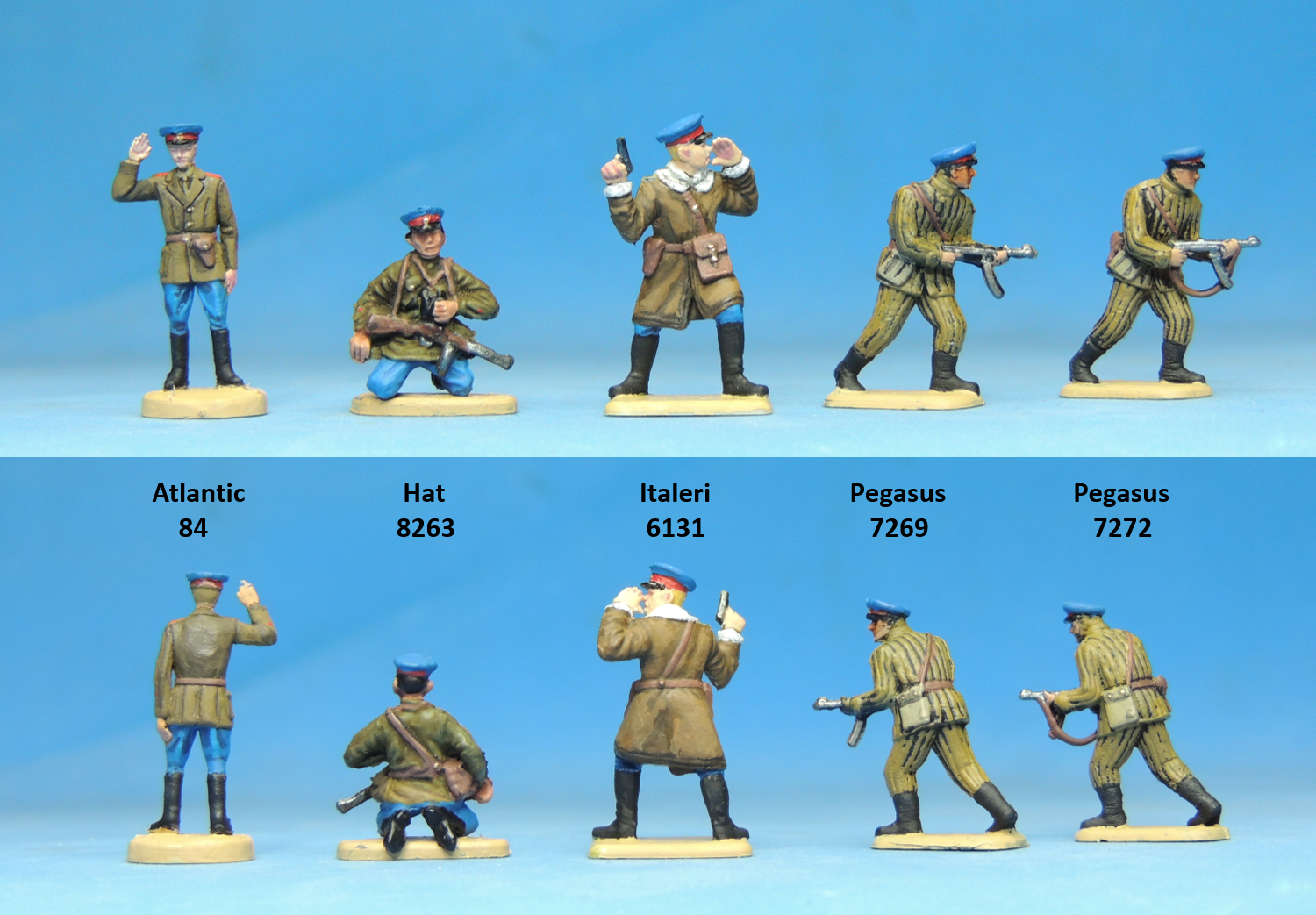
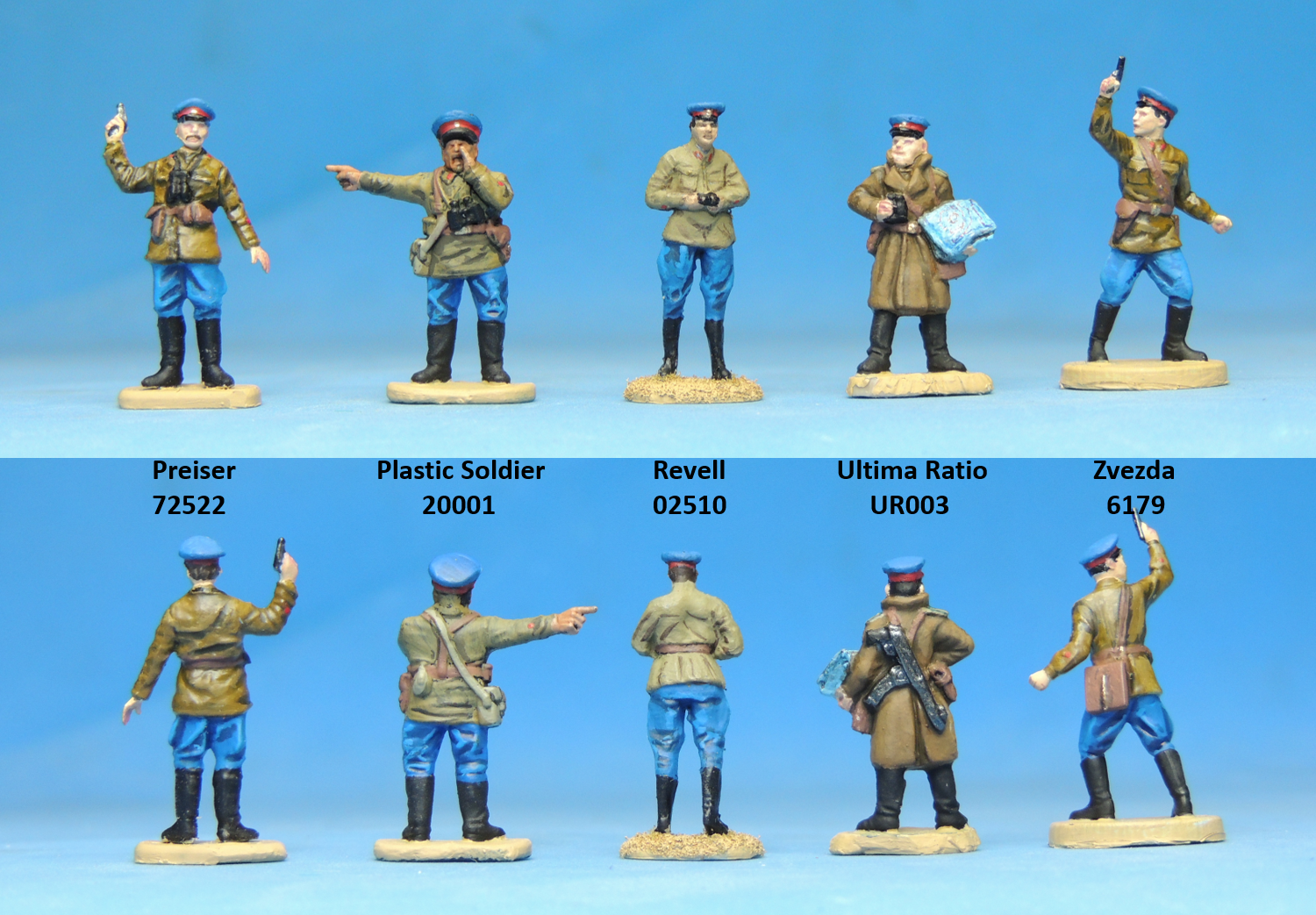

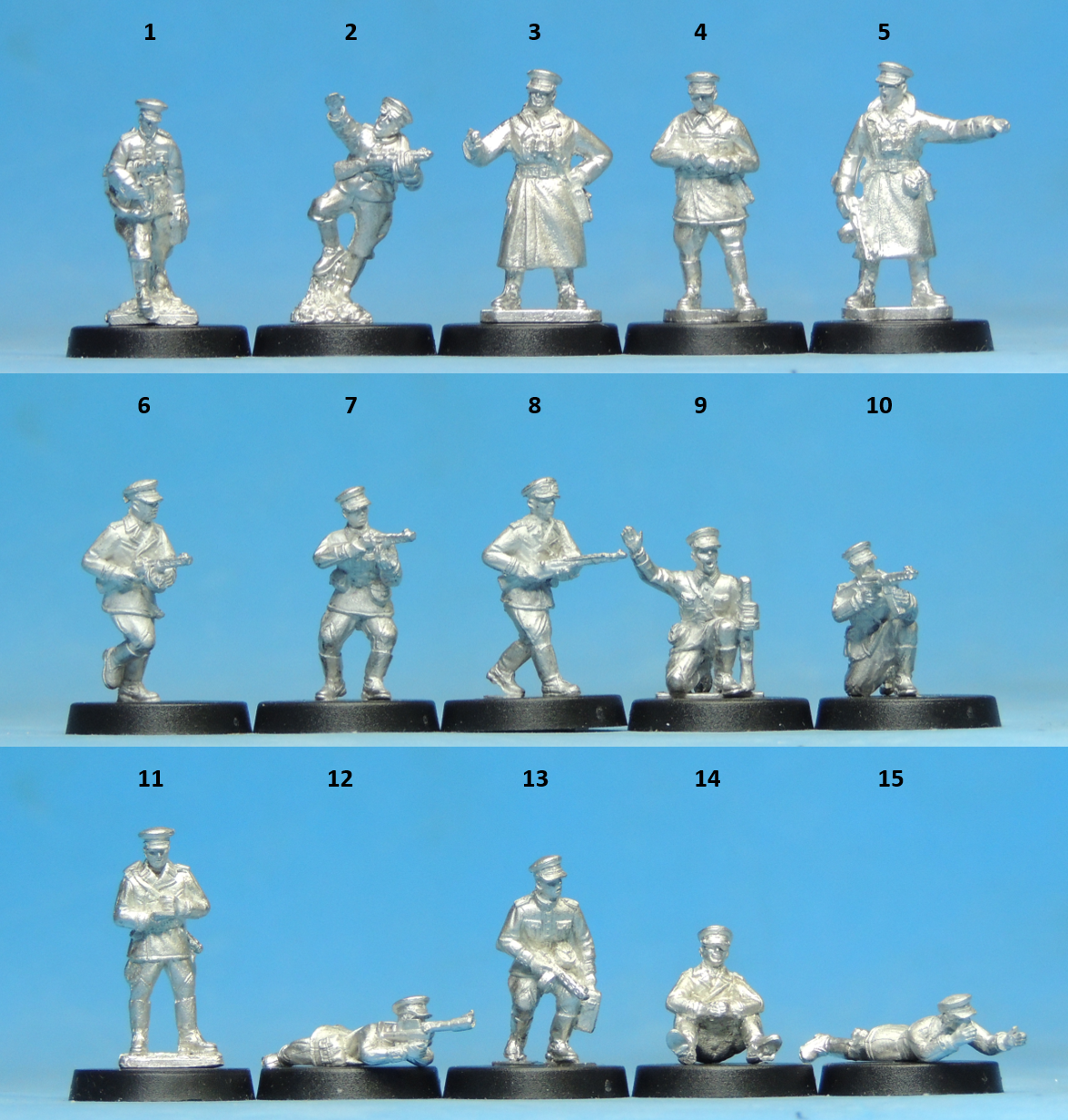
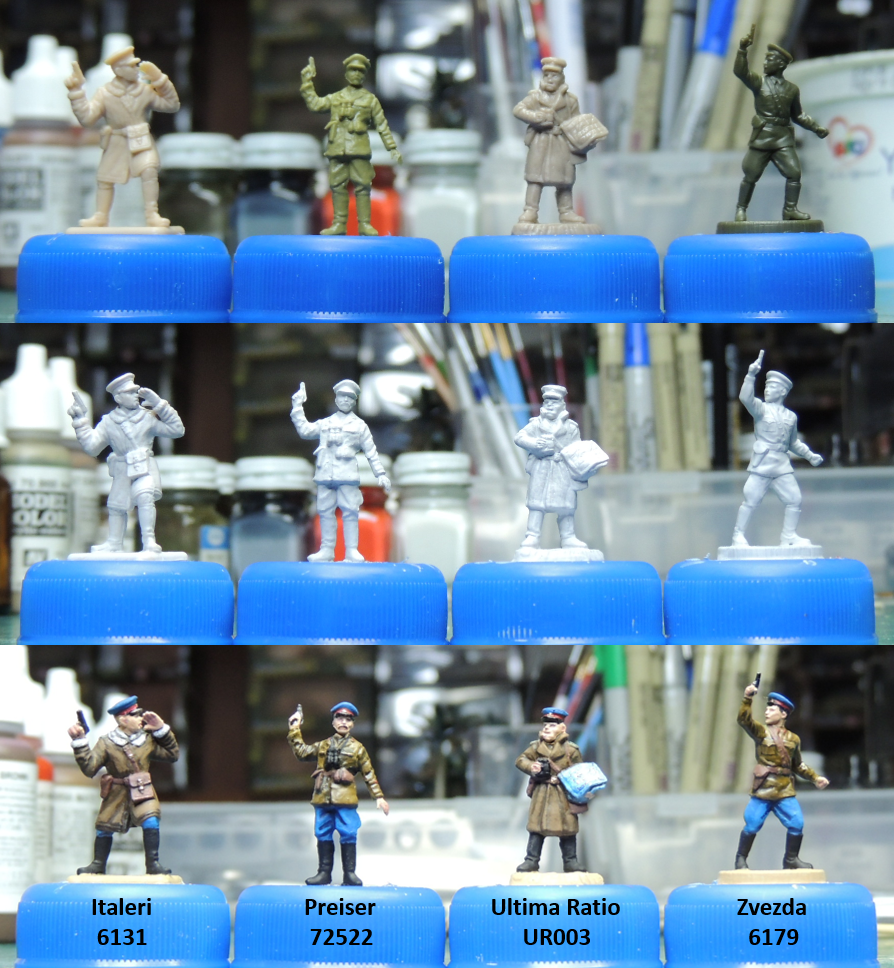
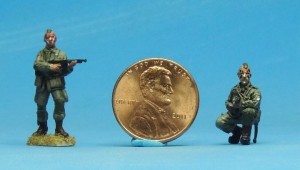
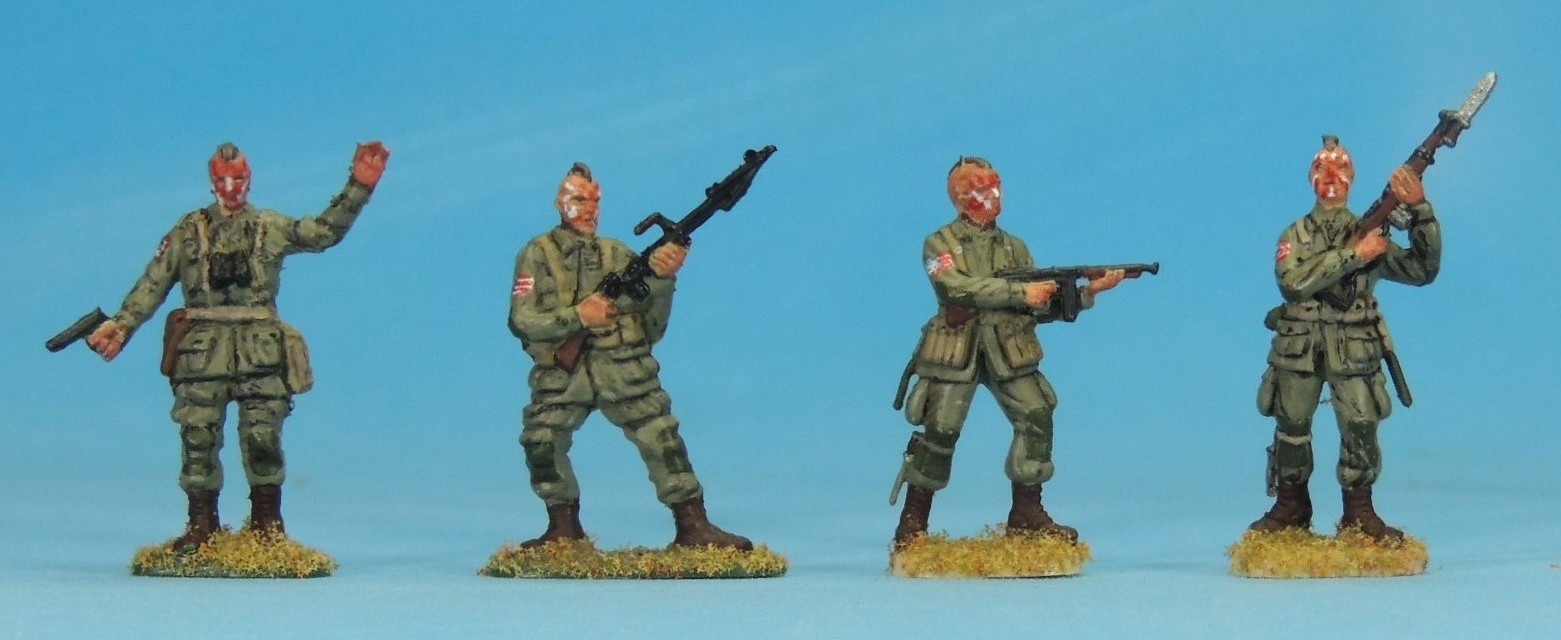
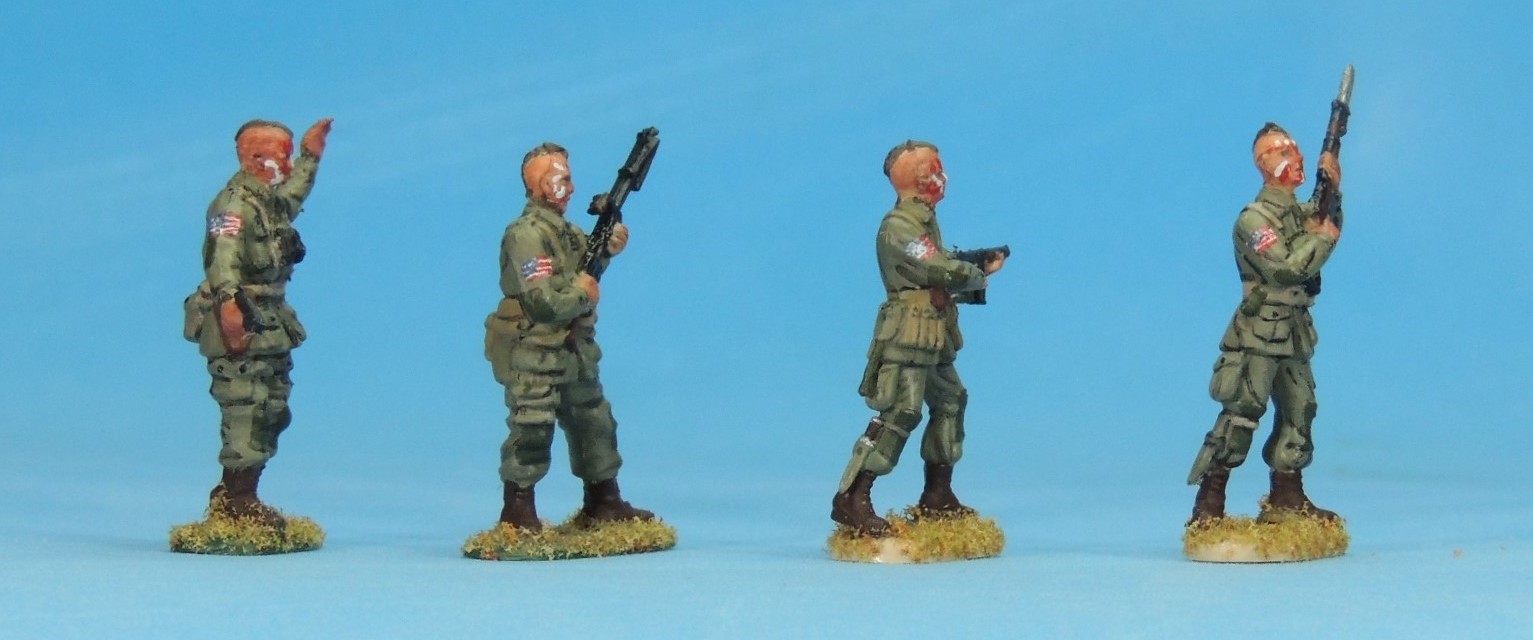
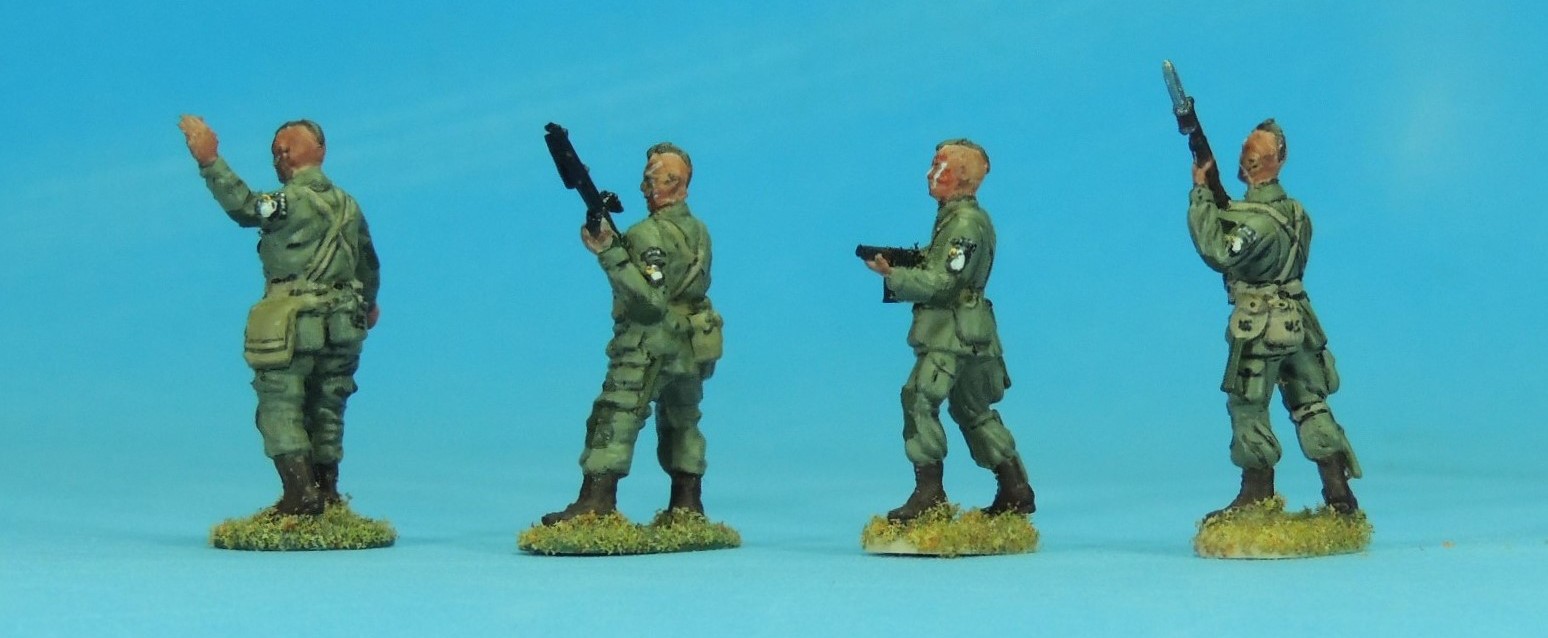
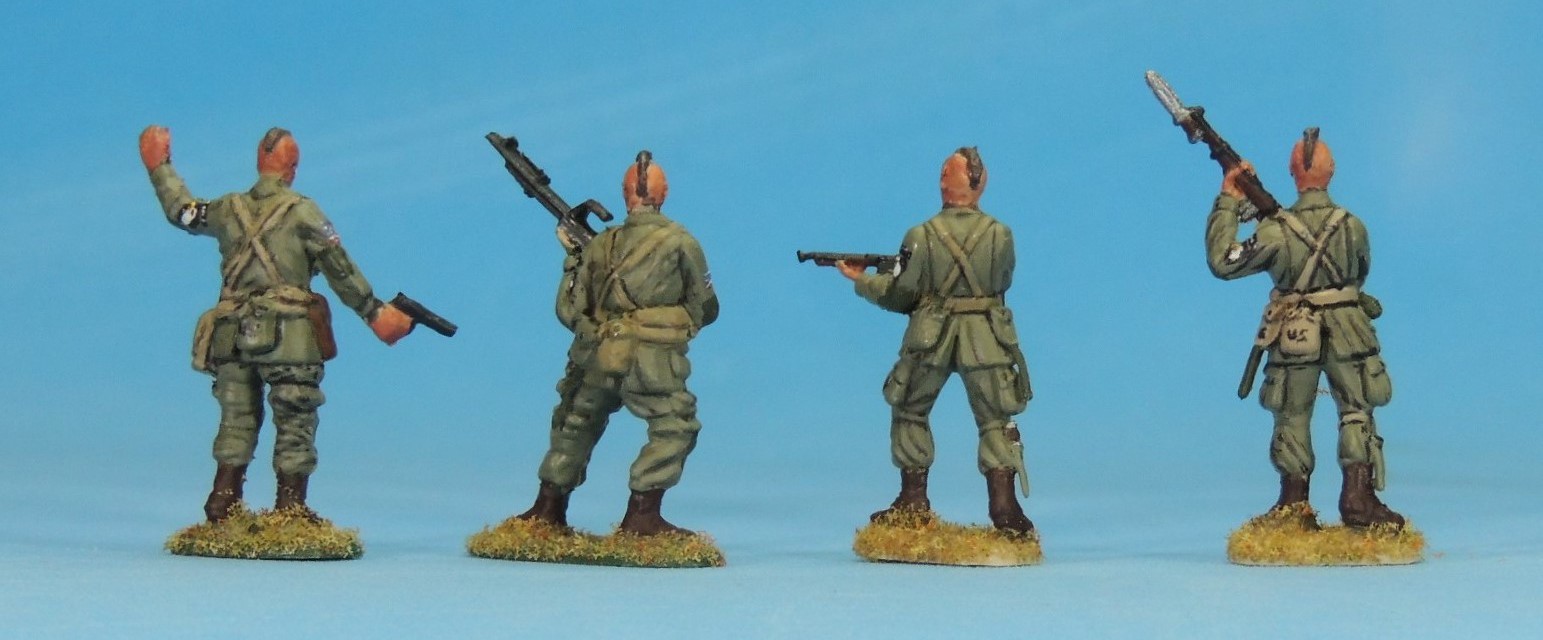
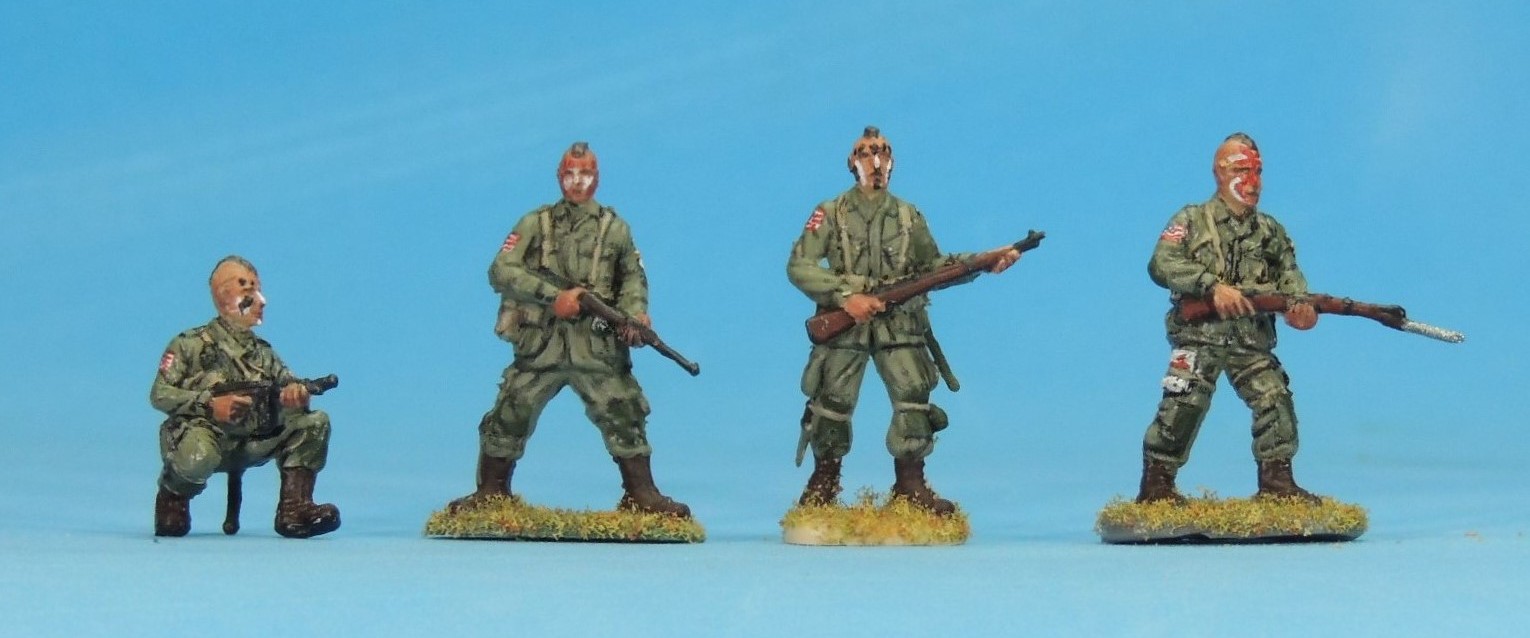
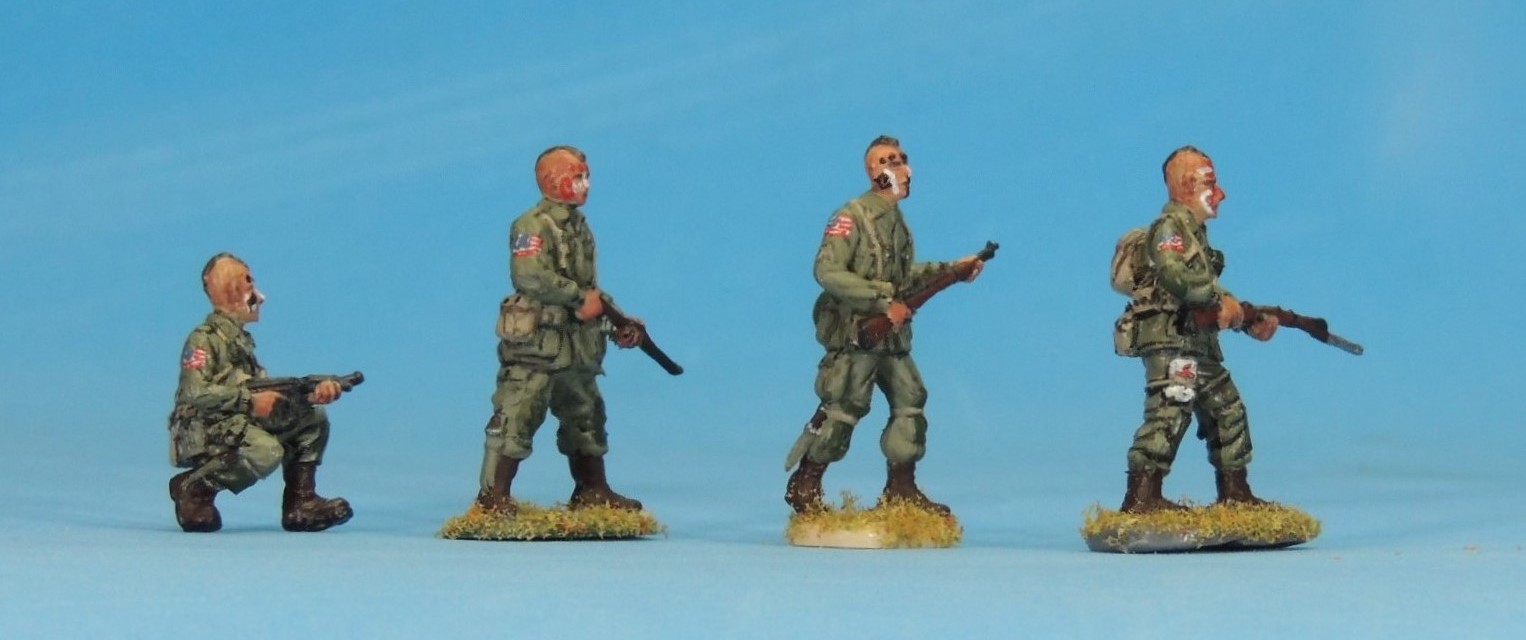
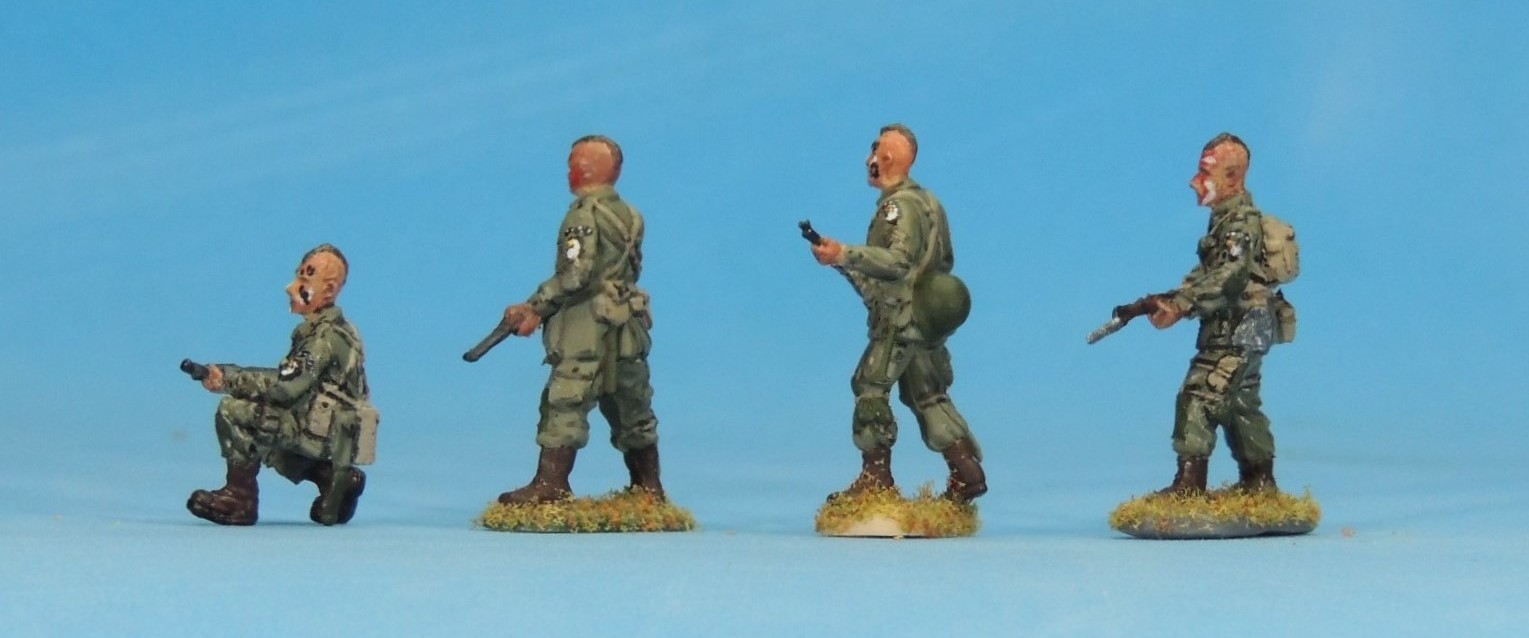
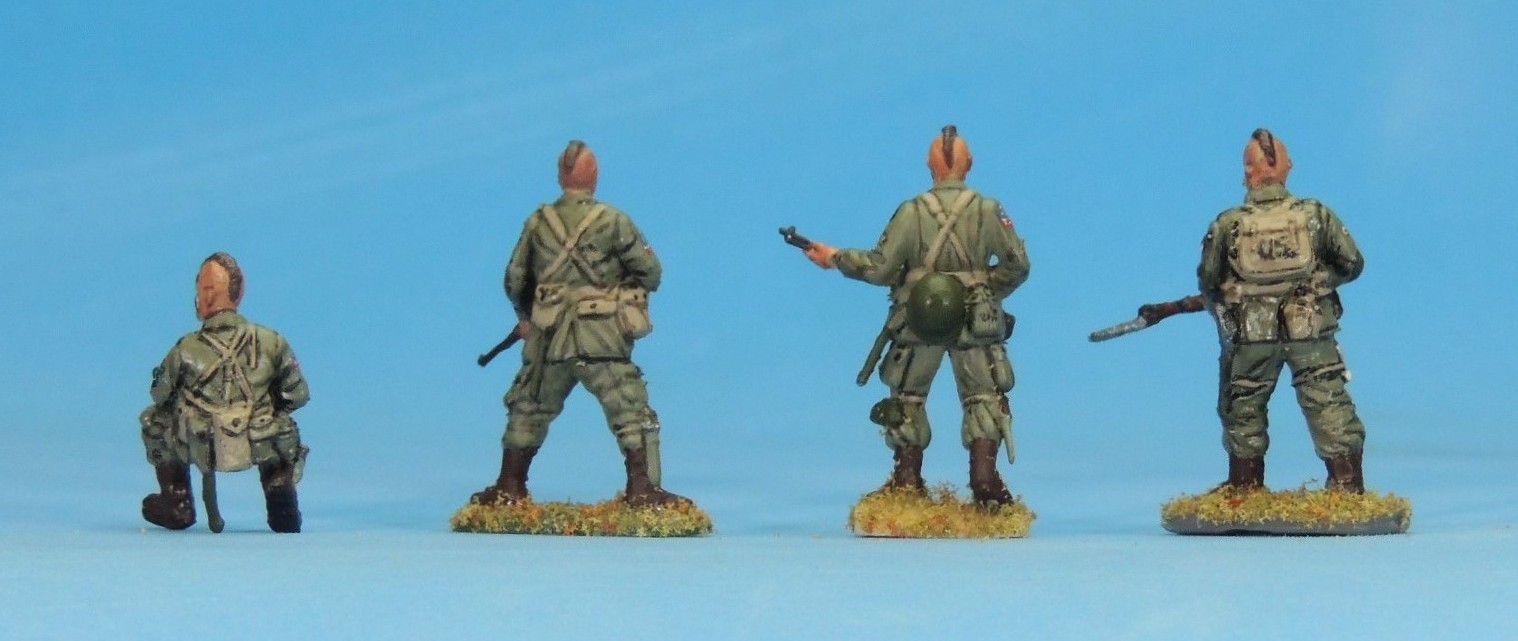

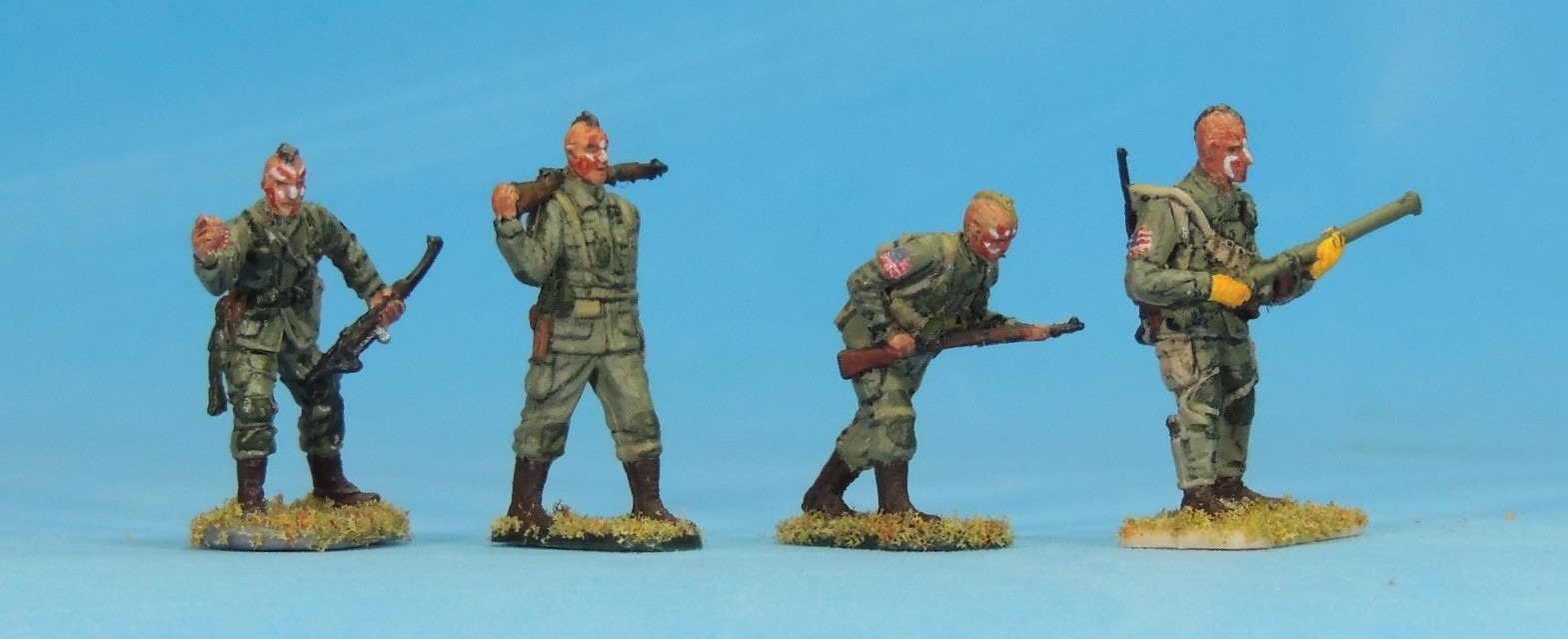

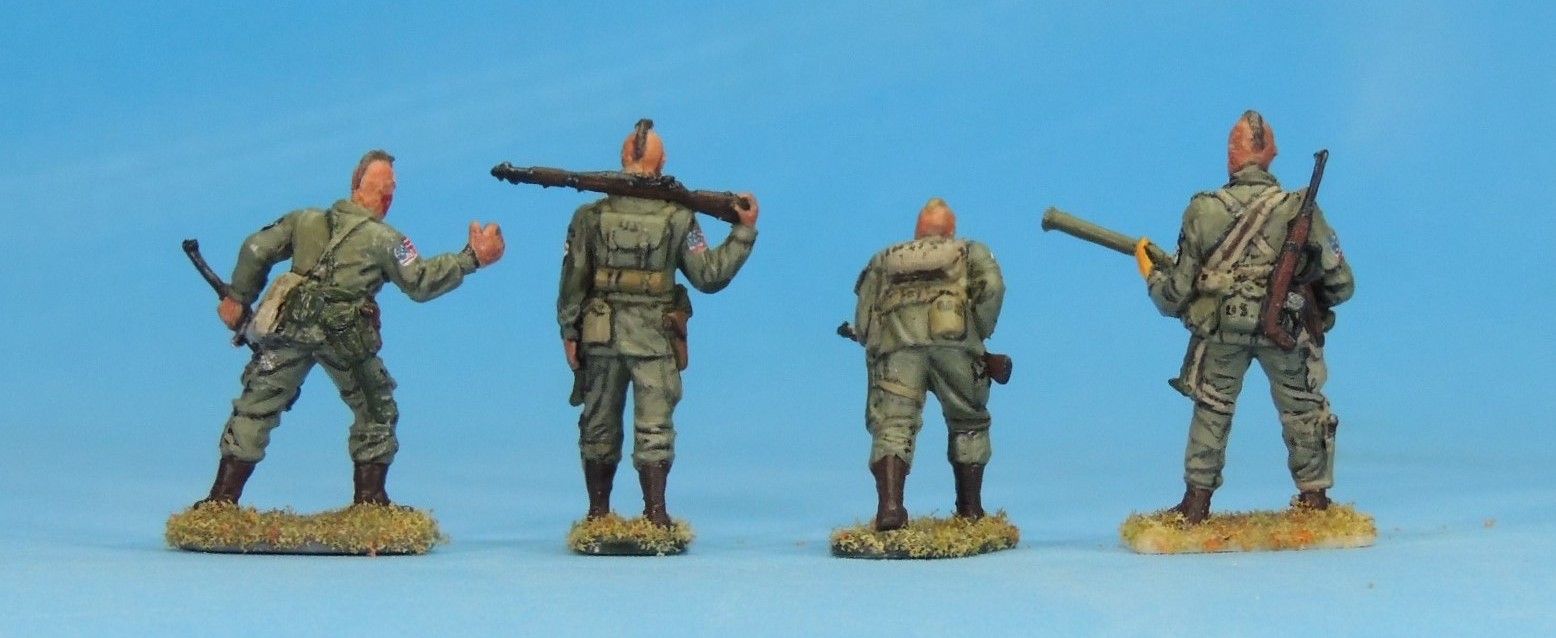
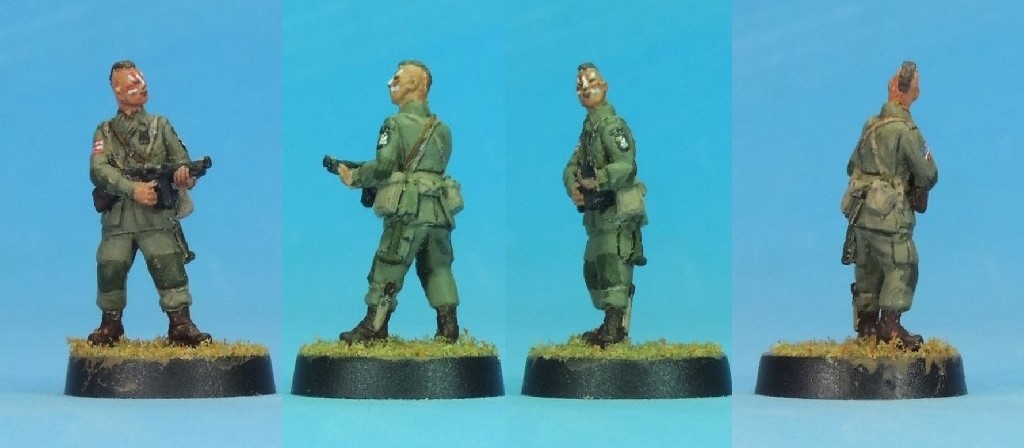
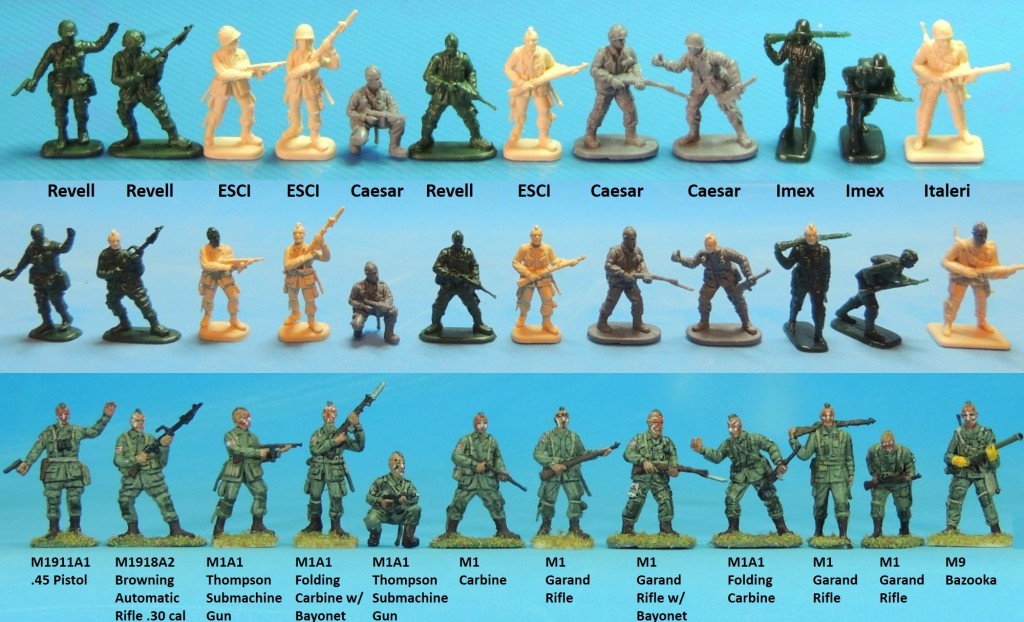

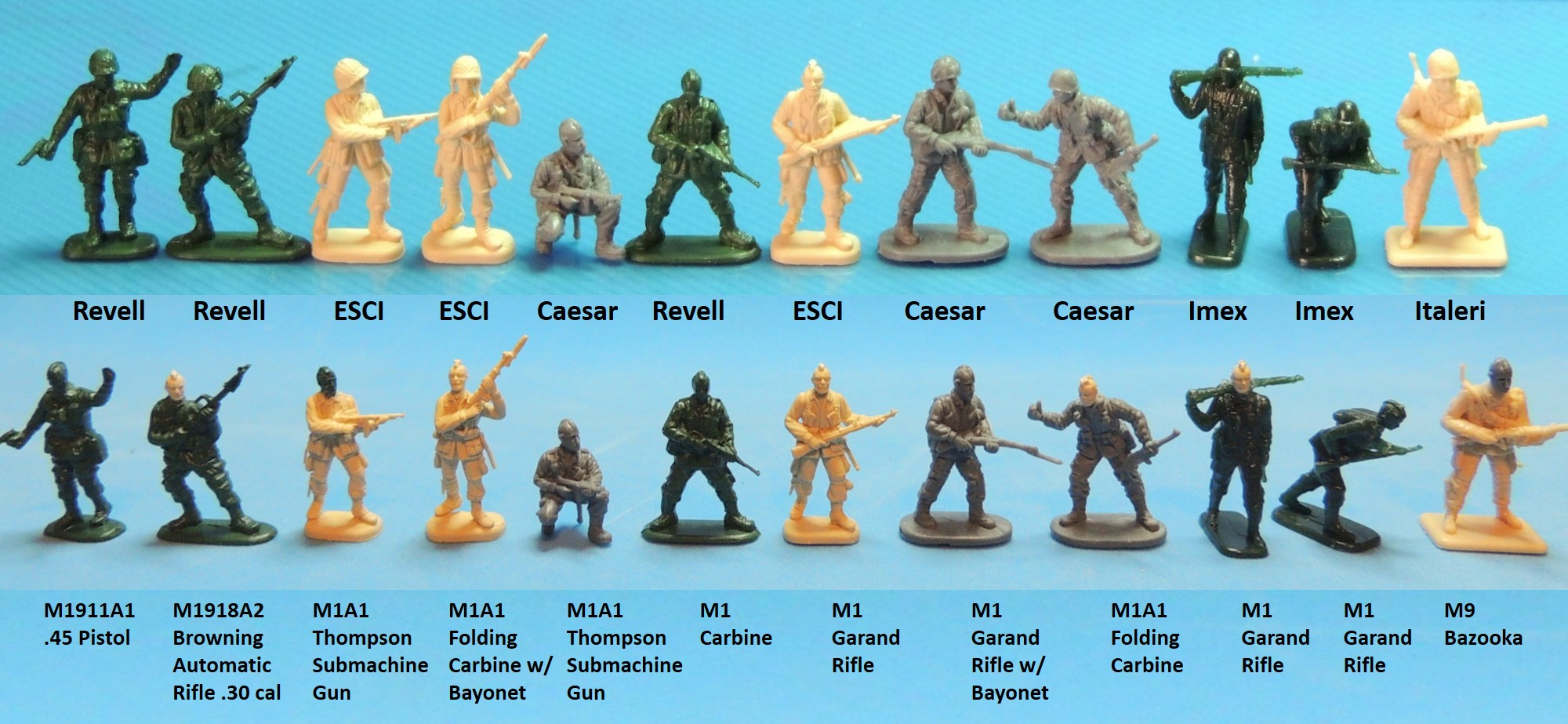
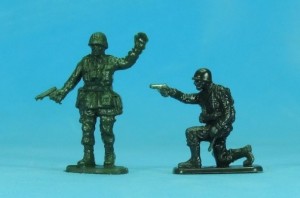
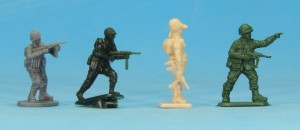
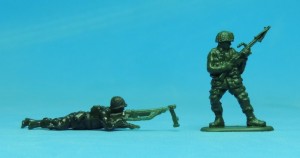
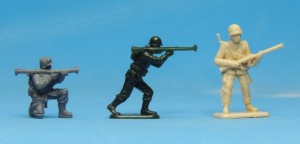

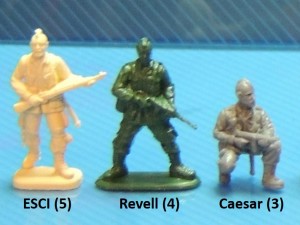 only exception, lacking sharpness in detail, though still not a bad effort. The ESCI, Revell, and Caesar sets each include one Pathfinder pose, fortunately with 5, 4, and 3 samples in each set, respectively. See photo inset at left. Thus, we have a total of 12 figures: three different ready-made figures and nine extra copies of those figures. To create 12 different figures with Mohawk haircuts, we take the heads of the nine extra copies and transplant them on the torsos of U.S. Airborne figures from the different sets.
only exception, lacking sharpness in detail, though still not a bad effort. The ESCI, Revell, and Caesar sets each include one Pathfinder pose, fortunately with 5, 4, and 3 samples in each set, respectively. See photo inset at left. Thus, we have a total of 12 figures: three different ready-made figures and nine extra copies of those figures. To create 12 different figures with Mohawk haircuts, we take the heads of the nine extra copies and transplant them on the torsos of U.S. Airborne figures from the different sets. 
